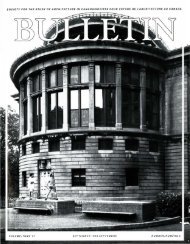CANADA - SEXTONdigital
CANADA - SEXTONdigital
CANADA - SEXTONdigital
Create successful ePaper yourself
Turn your PDF publications into a flip-book with our unique Google optimized e-Paper software.
G AVIN S TAMP > ESSAY I ESSAI<br />
Graves Commission interpreted and developed<br />
with remarkable sympathy and<br />
sophistication. Above all, perhaps, there<br />
was the work of Edwin Lutyens, whose<br />
Memorial to the Missing of the Somme<br />
at Thiepval is a supremely powerful and<br />
original creation in which, as Roderick<br />
Gradidge has claimed, he adopted "an entirely<br />
new three-dimensional approach to<br />
classical architecture".' But the monument<br />
erected by Canada at Vimy Ridge is consp<br />
icuous for standing outside that dominant<br />
tradition; in the work commissioned by<br />
or associated with the Imperial War Graves<br />
Commission, it is the great exception.<br />
FIG . 2. THE CENOTA PH, WHITEHALL, LONDON: EDWIN LUTYENS.j GAVIN STAMP 1984.<br />
of casualties during the war made some recompense<br />
by constructing cemeteries and so long, and so ruthlessly, ensured the sub<br />
systems which allowed it to be pursued for<br />
memorials of remarkable beauty and artistic<br />
quality. Some are among the greatest the arts. Yet, in fact, that war generated<br />
sequent rise to dominance of modernism in<br />
architectural achievements of the century. in the subsequent memorials a late but<br />
vital flowering of the European classical<br />
It is often assumed, with some justice, that tradition in architecture, if for a terrible<br />
the death toll and trauma of the Great War, purpose. And it was this tradition that the<br />
by discrediting the attitudes, traditions and architects employed by the Imperial War<br />
What was also remarkable about the<br />
work of the Commission was its secular<br />
and egalitarian character. This was not<br />
achieved w ithout considerable debate and<br />
struggle. The arguments were particularly<br />
passionate in particular over the use of<br />
Christian symbolism to commemorate the<br />
dead in a war in which men of many other<br />
religions, or none, had been fed into the<br />
slaughter. This debate also took place when<br />
it was proposed to rebuild the temporary<br />
Cenotaph as the national war memorial in<br />
the centre of Whitehall in London (fig. 2).<br />
That abstracted classical pylon, modelled<br />
and refined with extraordinary sophistication<br />
to give it remarkable emotional<br />
power, was also one of the supreme cre <br />
ations of Lutyens, the architect who would<br />
have more influence on the work of the<br />
War Graves Commission than any other. In<br />
1917, along with his former friend Herbert<br />
Baker (with whom he had fallen out over<br />
the design of New Delhi}, he was asked to<br />
visit the battlefields to see the problems of<br />
creating war graves at first hand. It was on<br />
this occasion that Lutyens wrote the letter,<br />
so often quoted, which reveals his response<br />
and his vision.<br />
What humanity ca n en dure and s uffer<br />
is beyon d belief The battlefiel d s - the<br />
obliter-a t ion of all human en deavour and<br />
6<br />
JSSAC I JSEAC 33 > N" 1 > 2008
















